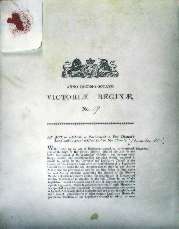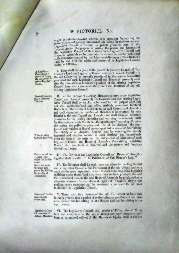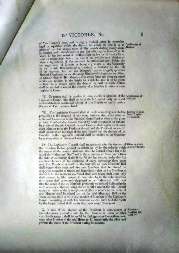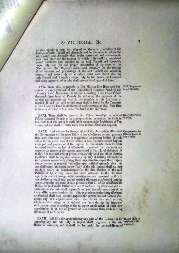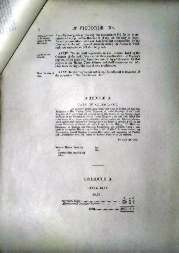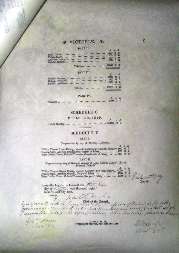

Constitution Act 1855 (Tas)
Significance
This document established an elected Parliament in Van Diemen's Land as provided for in the Australian Constitutions Act 1850. Section 32 of that Act allowed the Legislative Council to pass a law creating a Constitution, but stipulated that this law needed to be reserved for Royal Assent, rather than being assented to by the Governor. As this document shows, the Constitution was thus not enacted until 1855 when it received Assent, but is nonetheless known as the Constitution Act 1854.
History
The end of convict transportation to Van Diemen's Land in 1853 made this Act possible. The Act provided for the creation of 'The Parliament of Van Diemen's Land', to be the supreme lawmaking institution in the Colony. The limits to the Parliament's powers were defined by each arm of the British government: the executive bounds set by the exercise of the Royal Prerogative by Orders-in-Council and colonial governors; legislative bounds delimited by the British Parliament, and judicial bounds delimited by the hierarchy of courts of law whose apex was the Judicial Committee of the Privy Council.The new Parliament was to consist of two Houses. The Upper House, the Legislative Council, was to have 15 members who would retire by rotation, five every three years (Sections 1, 6, & 9). The Lower House would have 30 members elected at polls to be held every five years. (Sections 1, 15 & 16). Voters needed property or educational qualifications to elect Members to either House (Sections 6 & 17). Members of the Legislative Council had to be aged at least 30 years, but no minimum age was set for Members of the House of Assembly (Section 7).
Reference to 'officers of the Government' being liable to loss of office on 'political grounds' (Section 32), implies the idea of responsible government, that is, government conducted by a Ministry of Members of Parliament, so long as those Ministers enjoy the confidence of Parliament. The parliaments that came into existence in Tasmania, as in New South Wales, Victoria and South Australia all followed this model of government by ministries under the conventions of responsible government.
The House of Assembly was given no distinctive role in the formation of ministries, but was singled out in relation to money Bills, which were to originate there for recommendation to the Governor (Section 33). Most colonists wanted British conventions of bicameral government, and this is what this Constitution Act delivered.
The Act is a curiosity in being incomplete, or at least untidy. The Constitution was silent on the relationship between the two Houses, an issue which soon became important, and has remained so. In 1857 the House of Assembly denied, but the Legislative Council successfully asserted, a right to amend money Bills and withhold assent. That both Houses were elected and could claim an electoral constituency – representing either 'the people', or 'the best people' – gave some force to the view that their authority was equal. The Constitution, perhaps unintentionally, placed the Council in a stronger position in one important respect – unlike the Lower House, it could not be dissolved. In 1879, on a financial issue, the Upper House in effect went on strike, hindering government business by adjourning for three months. In 1926 the equal powers status was entrenched by a Constitutional amendment (16 George V no. 90) when Section 33 was repealed and Section 5 provided that the Legislative Council could reject any Bill.
The other two examples of seeming incompleteness or untidiness have not proved as constitutionally significant. No section in the Constitution empowers the Parliament to make laws for the peace, welfare and good government of the Colony – that is, no provision conveys a general law-making power and the Parliament is not empowered by any section of the 1855 Act to amend the Constitution.
The Tasmanian Constitution today is unchanged in these last two respects, but this has not prevented the exercise of a general law-making power, nor amendment to the Constitution. As Lumb has suggested, if the Constitution Act is read in conjunction with Section 32 of the 1850 Enabling Act (and also Section 14), the general law-making and amending powers are implied. The preamble of the current Tasmanian Constitution, consistent with Lumb's suggestion, declares that this original Constitution Act of 1855 had been passed in pursuance of the Australian Constitution Act 1850 (UK), which had been enacted 'for the purpose of securing the peace, welfare and good government' of the Colony. So, after 150 years the Australian Constitutions Act 1850 is still invoked to authorise Australian law-making!
Sources
Clark, Carrel Inglis, The Parliament of Tasmania: An Historical Sketch, Tasmanian Government Printer, Hobart, 1947.
Lumb, Richard, The Constitutions of the Australian States, University of Queensland Press, Brisbane, 1991.
Townsley, WA, The Struggle for Self-Government in Tasmania, 1842–1856, Tasmanian Government Printer, 1951.
Description
This document has nine parchment pages. The Royal Arms heads the first page and a wax/resin seal is attached by paper to the top left corner. Only a mere fragment of this survives. There is discolouration on each page and all curl under at the top and bottom. The last page of the document bears the signatures of Richard Dry, Speaker of the Legislative Council, Hartwell Henslowe, Clerk of the Council and W Denison, Lieutenant Governor. | Long Title: | An Act to establish a Parliament in Van Diemen's Land and to Grant a Civil List to Her Majesty (No. 17 of 1855) |
| No. of pages: | 9 |
| Medium: | Parchment |
| Measurements: | 26.5 x 35.5 cm |
| Provenance: | Parliament of Tasmania |
| Features: | Royal Arms on the front page with a fragment of a wax/resin seal on the top left corner
In Tasmania it is a legal requirement that an Assent original of legislation be deposited with the Supreme Court of Tasmania. |
| Location & Copyright: | Supreme Court of Tasmania |
| Reference: | None |
